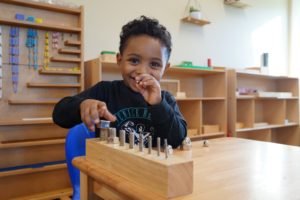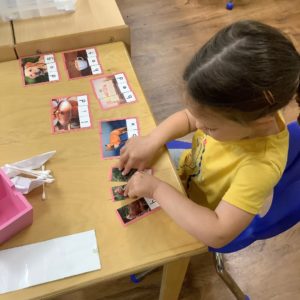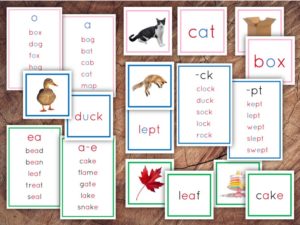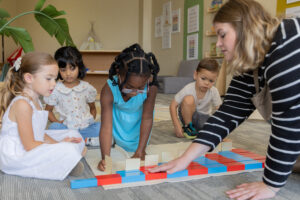
After 16 years in business, I’ve watched parents drop off their child probably thousands of times, observing them on and off the rest of the day through the observation window as I walk around the school. I know you love your child and want to make their day the best it can be, so I wanted to explain why dropping off your child before 8AM their first day and EVERY day is vitally important to their development and experience at school.
 What happens in the classroom at 8AM?
What happens in the classroom at 8AM?
At 8AM, our teachers are sitting down in Circle Time. They ask the children to sit on the big rug and welcome everyone, letting them know how happy they are to see them all. If it’s your child’s first day, the teacher will introduce your child to the class, sing a song for the week that the children learn to sing with her, and for older children, go over the calendar so the children learn the concepts of present, past and future and teach a group lesson. Circle Time is layered with many learning moments but also social ones, lasting about 10 minutes. Children who are dropped off after 8:10AM miss all that.
What about after 8:10AM?
From 8:10AM to about 11AM, the children engage in what we call the Montessori uninterrupted work period. The uninterrupted work period is fundamental to the Montessori approach. Within the Montessori environment, children need to have time to work through various tasks and responsibilities at their own pace. This uninterrupted work period is critical because that is when the building of coordination, concentration, independence and order, and the assimilation of all that they’ve learned that morning, occur.
Through observation and experimentation, Dr. Maria Montessori discovered the importance of a two-and-a-half to three-hour uninterrupted work period. The last hour of a lengthy work period is usually when children are most likely to choose challenging work and concentrate deeply, which cannot possibly happen if dropped off at 9AM. Dr. Montessori carefully observed the phases of children’s work during long work periods. She noted that in the first hour and twenty minutes, children often chose an easy initial task, followed by a moderately challenging activity, and then a difficult one. When the work period is less than two hours long, children rarely experience the deep concentration where leaps of cognitive development can take place. Children are understandably hesitant to choose challenging work if they think they won’t have time to complete it or repeat it. Here is a more in-depth article on the Montessori work period. The bottom line is that the less time they have to work uninterrupted, the less likely they are to choose more challenging work or develop deep levels of concentration. And those periods are when the big connections are made.
a lengthy work period is usually when children are most likely to choose challenging work and concentrate deeply, which cannot possibly happen if dropped off at 9AM. Dr. Montessori carefully observed the phases of children’s work during long work periods. She noted that in the first hour and twenty minutes, children often chose an easy initial task, followed by a moderately challenging activity, and then a difficult one. When the work period is less than two hours long, children rarely experience the deep concentration where leaps of cognitive development can take place. Children are understandably hesitant to choose challenging work if they think they won’t have time to complete it or repeat it. Here is a more in-depth article on the Montessori work period. The bottom line is that the less time they have to work uninterrupted, the less likely they are to choose more challenging work or develop deep levels of concentration. And those periods are when the big connections are made.
What is the ideal time then to drop off my child?
 Anytime before 7:45AM. Why? Because the children are playing outside! They have the chance to get their wiggles out, talk to friends, and get the blood pumping before starting work time. Children who are able to play first experience a much more productive time in class and it makes sense. We ALL need that. What do you do when you first get to work? You don’t just sit down and start. You say hello to people, put your things away, maybe get a cup of coffee, ask a colleague about their weekend, all sorts of rituals and allow your brain to slowly switch to “work mode.” Your child needs that time to orient themselves, too.
Anytime before 7:45AM. Why? Because the children are playing outside! They have the chance to get their wiggles out, talk to friends, and get the blood pumping before starting work time. Children who are able to play first experience a much more productive time in class and it makes sense. We ALL need that. What do you do when you first get to work? You don’t just sit down and start. You say hello to people, put your things away, maybe get a cup of coffee, ask a colleague about their weekend, all sorts of rituals and allow your brain to slowly switch to “work mode.” Your child needs that time to orient themselves, too.
What else happens if I’m late dropping off my child?
When a child is dropped off after 8AM, they are stared at (which I can attest is extremely uncomfortable) and interrupt the work of others. Children cannot help but react to interruptions, which is another reason why we ask our families to drop off earlier than 8AM. Another reason to drop off early or on time? Your child isn’t missing a learning opportunity. During the morning work period, children receive individual or small group lessons, work at their own pace with materials they choose, and serve themselves snack. The teachers almost always have a group lesson to teach or food prep to show or a book to highlight or any other numbers of things that Circle Time encompasses. If a child is later than 8:10AM, they are missing out on time to work with materials and make connections. There is also a risk that the teacher will skip over them for their one-on-one group lesson time. Each morning, while the class is working on materials they choose from the shelves, the Lead Teacher is taking one to four students to a corner of the classroom and teaching them a new concept, like how to count to 1,000 (Golden Beads work) or practice writing (Metal Inset) or reading (Pink Material). Afterwards, they typically want to practice what they’ve learned. So MUCH is going on from 8 – 11AM!
missing a learning opportunity. During the morning work period, children receive individual or small group lessons, work at their own pace with materials they choose, and serve themselves snack. The teachers almost always have a group lesson to teach or food prep to show or a book to highlight or any other numbers of things that Circle Time encompasses. If a child is later than 8:10AM, they are missing out on time to work with materials and make connections. There is also a risk that the teacher will skip over them for their one-on-one group lesson time. Each morning, while the class is working on materials they choose from the shelves, the Lead Teacher is taking one to four students to a corner of the classroom and teaching them a new concept, like how to count to 1,000 (Golden Beads work) or practice writing (Metal Inset) or reading (Pink Material). Afterwards, they typically want to practice what they’ve learned. So MUCH is going on from 8 – 11AM!
Is developing a morning routine THAT important?
 Children are incredibly sensitive to routine. I’m sure you’ve noticed. 😉 When infants and toddlers are part of familiar activities and routines, they develop relationships with the people they interact with and gain a sense of belonging and self-confidence. As older toddlers and young children grow, they can follow routines, demonstrate emerging independence, and adjust to change more easily. It can be hard to remember how sensitive children can be to very minor changes in their routine. As adults we learn to adjust ourselves to accommodate unexpected bumps and turns in the road. Children do not yet have these tools. Regularity helps them to feel safe. It eases their anxiety. It allows them to grow, to learn, to be happy. Of course life can get in the way sometimes, but that is for us, the adults, to figure out.
Children are incredibly sensitive to routine. I’m sure you’ve noticed. 😉 When infants and toddlers are part of familiar activities and routines, they develop relationships with the people they interact with and gain a sense of belonging and self-confidence. As older toddlers and young children grow, they can follow routines, demonstrate emerging independence, and adjust to change more easily. It can be hard to remember how sensitive children can be to very minor changes in their routine. As adults we learn to adjust ourselves to accommodate unexpected bumps and turns in the road. Children do not yet have these tools. Regularity helps them to feel safe. It eases their anxiety. It allows them to grow, to learn, to be happy. Of course life can get in the way sometimes, but that is for us, the adults, to figure out.
As inconvenient and challenging as it may be for us, children thrive in an orderly world and that includes being dropped off at about the same time every day before 8AM. Help your child to see that consistency every day and you might be surprised at what they and all the children enrolled at Jarrell Montessori can accomplish.
~ Shannon Black, Founder/Co-Owner of Jarrell Montessori

